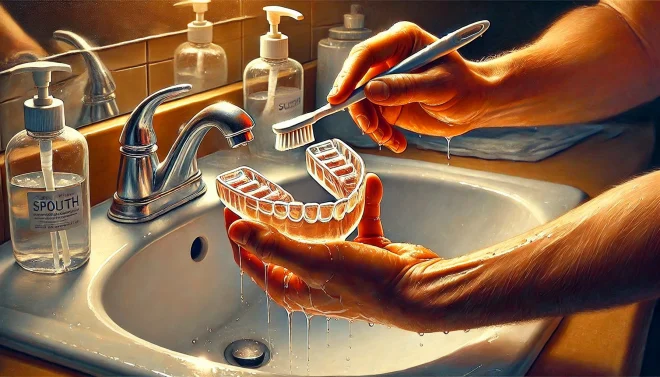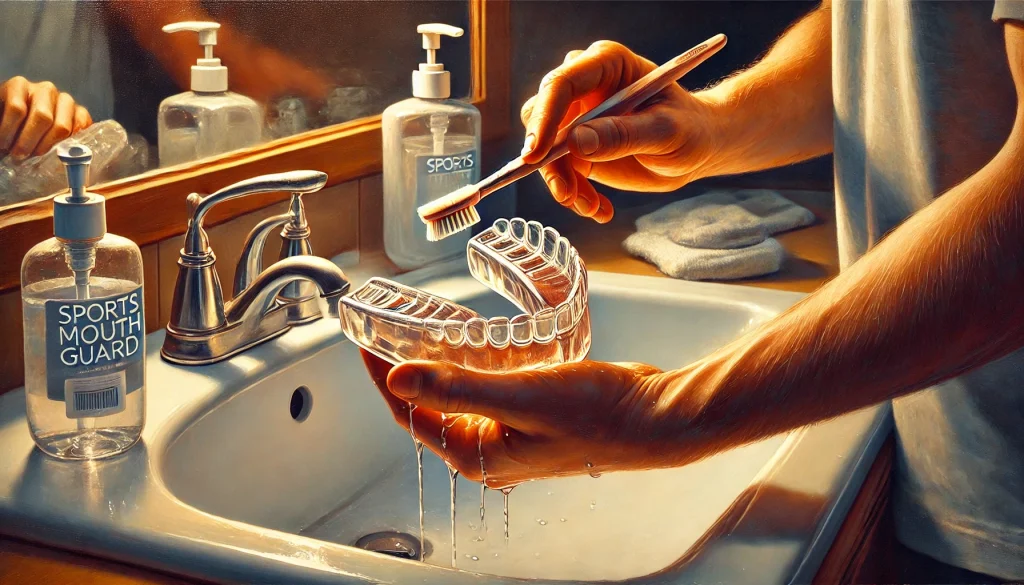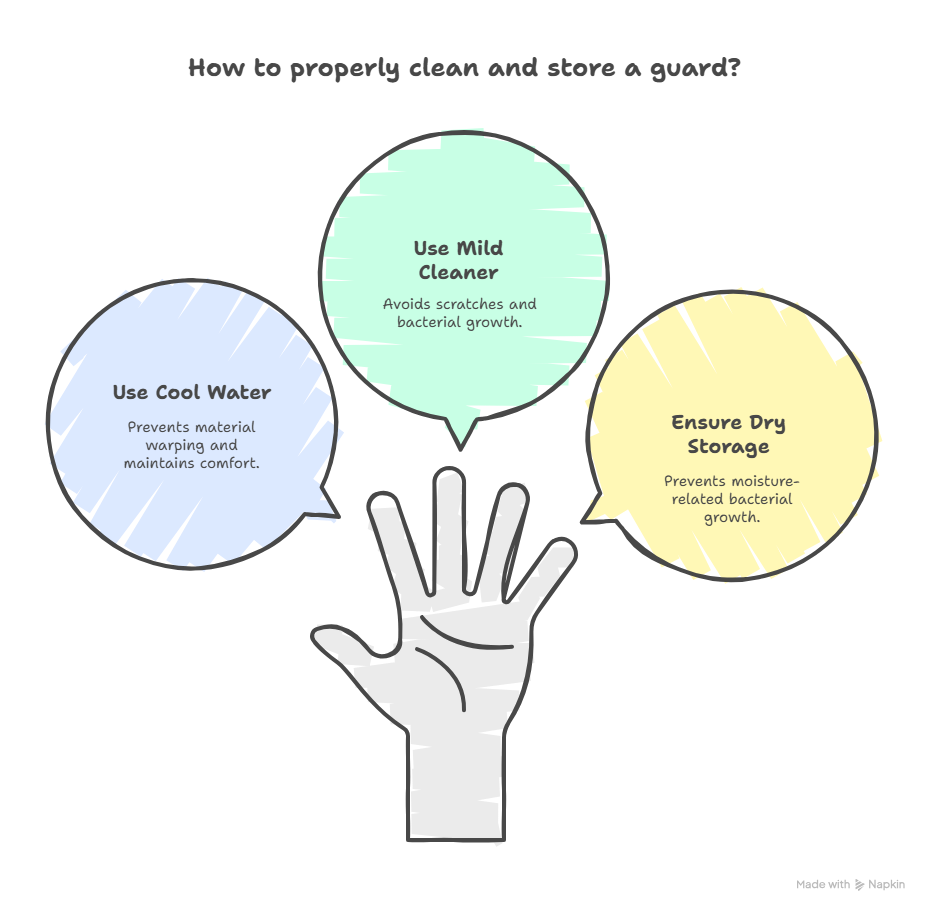
Your mouth guard really takes a beating, shielding your teeth from nighttime grinding or protecting your jaw when you’re active. But here’s the thing: if you’re not giving it a good cleaning, it can turn into a hangout spot for germs. That can lead to stinky breath, irritated gums, and even some nasty infections. Plus, a dirty guard won’t last as long, meaning you’ll have to shell out more cash for a new one sooner.
This guide will walk you through the best ways to keep your mouth guard fresh and safe. From simple daily habits to more intense weekly cleans, we’ll show you dentist-recommended techniques that not only keep your mouth healthy but also help your guard last longer.
Why Cleaning a Mouth Guard is Essential
Your mouth guard is like a little sponge that hangs out with your teeth all night (or day!), collecting saliva and tiny crumbs. If you don’t give it a good scrub, it turns into a party pad for nasty bacteria. And nobody wants that! Think bad breath, gunk buildup, grumpy gums, and even mouth problems.
But a clean mouth guard? That’s a happy mouth guard! It smells good, feels good, lasts longer, and actually helps keep your teeth and gums healthy, instead of the opposite. Basically, cleaning it is a must-do, not a maybe, if you want it to do its job right.
Daily Cleaning Routine
Step 1: Rinse Immediately After Use
Right after you’re done using your mouthguard, give it a quick rinse with cool or slightly warm water. This washes off any spit and bits of stuff that might be on it, stopping germs from growing. Just remember, no super hot water! It can mess up the shape and make it not fit right.
Step 2: Gentle Brushing
Give your mouth guard its own special toothbrush with soft bristles. Put a small amount of gentle soap (one without alcohol) or a toothpaste that isn’t harsh (skip the whitening ones, they can scratch) on the brush. Carefully clean the entire mouth guard, but be gentle! Don’t scrub too hard. Using rough stuff or scrubbing roughly can create tiny scratches where yucky germs can hide.
Step 3: Air Drying
Once you’ve washed off all the suds or toothpaste, just lay your guard down on a nice, clean, even spot and allow it to dry on its own. Water can really help germs grow, so it’s important to be absolutely sure it’s totally dry before putting it back into its container.

ALT TAG: A realistic painting of a person carefully cleaning a sports mouth guard at a sink
Weekly Deep Cleaning Methods
Even if you’re diligent about cleaning your mouth guard every day, it still needs a good, thorough cleaning now and then to get rid of any remaining germs and keep it feeling fresh. Try to give it a more intense clean at least once a week. Here are four options that dentists recommend:
Option 1: Diluted Alcohol-Free Mouthwash
Mix one part alcohol-free mouthwash with three parts water. Soak your guard for 10 to 30 minutes, then rinse thoroughly. This leaves it fresh without the harsh drying effects of alcohol.
Option 2: White Vinegar and Warm Water Soak
Mix the same amount of plain white vinegar and lukewarm water in a fresh cup or bowl. Place your mouthguard in the solution and let it sit for no more than half an hour. After that, give it a good rinse and allow it to dry completely on its own. Vinegar is a natural germ-fighter and can help get rid of bad smells.
Option 3: Baking Soda Paste
Mix together some baking soda and water until it forms a nice, smooth paste. Then, grab a soft toothbrush and gently spread the paste all over your guard, like you’re brushing it. Make sure to rinse it really well with water when you’re done. This helps get rid of any smells and loosen up gunk on the surface without scratching things up.
Option 4: Hydrogen Peroxide (3%) Soak
Place your guard in a cup of 3% hydrogen peroxide for 10–15 minutes, then rinse well under cool water. Hydrogen peroxide bubbles away bacteria and stains, giving your guard a deep refresh.
One Thing You Should Know: Never soak for longer than 30 minutes, regardless of the method. Over-soaking can weaken the material of your mouth guard.
Proper Storage
Once your guard is clean and completely dry, where you keep it matters just as much as how you clean it.
- Use a ventilated case: Choose one with small holes to allow airflow and prevent trapped moisture.
- Avoid closed, damp containers: Bacteria thrive in wet, airtight environments.
- Keep it away from heat and direct sunlight: Just like with hot water, heat can warp the guard.

A clean, dry, and ventilated case is the best insurance policy for keeping your mouth guard hygienic and in good condition for the long haul.
Common Mistakes to Avoid
Even the most diligent cleaners can slip up. Here are three of the most common mistakes and why you should steer clear of them:
- Using hot water: Heat can warp the material, leaving your guard misshapen and uncomfortable. Always stick to cool or lukewarm water.
- Scrubbing with abrasive toothpaste: Whitening and gritty pastes can scratch the guard’s surface, creating tiny grooves where bacteria love to hide. Opt for mild, nonabrasive cleaners instead.
- Storing while still wet: Moisture trapped in a case is like rolling out the welcome mat for bacteria. Make sure your guard is fully air-dried before storage.
Expert-Backed Advice and Sources
These cleaning practices aren’t just good habits, they’re dentist-approved. Clinics and experts across the board recommend the same approach:
- Aperture Dental emphasizes rinsing immediately, using mild soap or toothpaste, and letting the guard air dry.
- Healthline highlights deep cleaning options like baking soda, vinegar, mouthwash, and hydrogen peroxide.
- Collins Dental Care advises against harsh toothpaste, underscoring the importance of gentle daily brushing.
- Sugar Hill Dentistry details soaking methods with vinegar or hydrogen peroxide and stresses proper storage.
With consistent guidance from trusted dental professionals, you can be confident that these methods are both safe and effective.
Conclusion
Caring for your mouth guard doesn’t have to be complicated. Stick to the golden trio:
- Daily care: Rinse, brush gently, and air dry.
- Weekly deep clean: Rotate between safe soaking methods like vinegar, hydrogen peroxide, or diluted mouthwash.
- Proper storage: Keep it in a clean, ventilated case only after it’s completely dry.
Follow these steps, and you’ll not only prevent bacteria, odors, and irritation but also extend the life of your mouth guard. In other words, a clean guard equals better oral health and a more comfortable, long-lasting fit.
Frequently Asked Questions
1. Can I boil my mouth guard to clean it?
No. Boiling water or very hot water can warp the material, making your mouth guard unusable. Stick to cool or lukewarm rinses and safe soaking solutions.
2. How often should I deep clean my mouth guard?
A deep clean once a week is ideal. Daily rinsing and brushing are important, but soaking ensures bacteria, odors, and buildup don’t linger.
3. Can I use regular toothpaste on my mouth guard?
It’s best to avoid whitening or abrasive toothpastes. They can scratch the surface, creating tiny grooves that trap bacteria. Instead, use mild, nonabrasive toothpaste or soap.
4. What should I do if my mouth guard still smells after cleaning?
Try a deep clean with vinegar or hydrogen peroxide. If the odor persists, it may be time to replace the guard, as older devices can retain smells even after thorough cleaning.
5. How long does a mouth guard typically last?
With proper care, daily cleaning, weekly deep cleaning, and proper storage, most mouth guards last 1 to 2 years. However, if you notice cracks, warping, or persistent odors, it’s best to replace it sooner.
GIPHY App Key not set. Please check settings